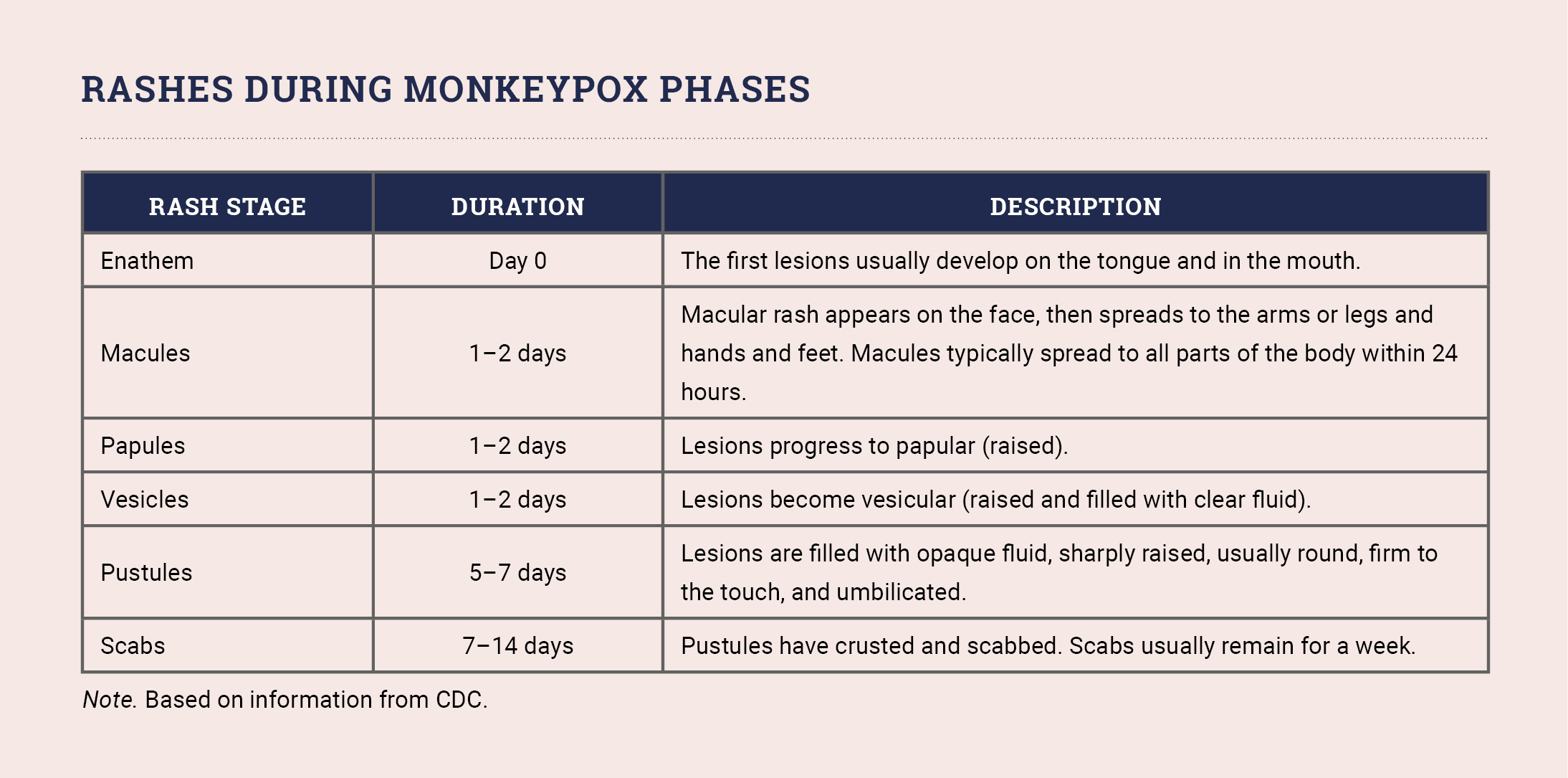Monkeypox Fact Sheet and Implications for Patients With Cancer
In May 2022, the Centers for Disease Control and Prevention began tracking (https://www.cdc.gov/poxvirus/monkeypox/response/2022/index.html) cases of monkeypox in the United States, a disease caused by infection with the monkeypox virus. As of August 2022, 48 U.S states have reported (https://www.cdc.gov/poxvirus/monkeypox/response/2022/index.html) at least some level of monkeypox diagnoses, and the World Health Organization declared (https://doi.org/10.1001/jama.2022.12513) the virus a global public health emergency.
How Does Monkeypox Manifest?
Symptoms generally begin (https://www.cdc.gov/poxvirus/monkeypox/index.html) within three weeks of exposure, and the illness typically lasts two to four weeks. Monkeypox disease progresses through three phases: incubation, prodrome, and rash. The incubation period typically lasts one to two weeks, where an infected person typically doesn’t experience symptoms and is not contagious. The prodromal period is marked by early symptoms (e.g., fever, headache, malaise, lymphadenopathy; see sidebar); then, a rash appears and progresses through several stages (see sidebar). Infected individuals are considered contagious from prodrome to the final rash stage.
How Is Monkeypox Spread?
Transmission of monkeypox virus can occur through:
- Close, personal contact (often skin-to-skin contact), including direct contact with monkeypox rash, body fluids, or respiratory secretions as well as fabrics or surfaces used by someone with monkeypox disease
- The placenta of a pregnant person with monkeypox disease to a fetus
Data are lacking whether the virus can be spread when someone is asymptomatic; via semen, vaginal fluids, urine, or feces; or how often monkeypox is spread through respiratory secretions. CDC did not categorize (https://www.cdc.gov/poxvirus/monkeypox/index.html) monkeypox as airborne. Patients who are younger than age 8, immunocompromised, pregnant, or have a history of atopic dermatitis or eczema are at risk (https://www.cdc.gov/poxvirus/monkeypox/index.html) for more severe infections.
What Should I Know as an Oncology Nurse?
Monkeypox can be mistaken for other conditions that present with rash, but it has a few distinguishing characteristics (https://www.cdc.gov/poxvirus/monkeypox/index.html):
- Lesions are deep-seated, well-circumscribed, and umbilicated (having a small depression like a navel).
- Lesions are contained in a single body area and are usually the same size and in the same stage of development.
- The rash is centrifugal (appearing more on the extremities or face).
- Lesions can appear on the palms or soles.
- A fever appears before the rash, and lymphadenopathy is common.

Could My Patient Have Shingles, not Monkeypox?
Patients with cancer may commonly experience (https://doi.org/10.1093/infdis/jiy625) shingles (herpes zoster), a disease that can closely resemble monkeypox. Both can cause fever, headache, chills, and rash, but the rash appears differently for each disease. Monkeypox lesions tend to appear on the face first and then spread to other areas of the body in a scattered pattern. Shingles lesions typically form in bands or stripes and don’t generally cross the midline of the body, although it can rarely be more widespread and appear like chicken pox in immunocompromised patients. Both rashes can be described as painful, but a shingles rash is characterized by a constant dull, burning, or stabbing pain along the rash’s path. Patients could also be coinfected (https://doi.org/10.4269/ajtmh.20-0589) with monkeypox and another infectious agent, so testing is key.
How Is Monkeypox Prevented and Treated?
Two monkeypox vaccines are approved in the United States, but both contain live virus (one is nonreplicating live virus) and may be contraindicated for people with cancer. Learn more (https://www.cdc.gov/poxvirus/monkeypox/clinicians/smallpox-vaccine.html#anchor_1545415186164) about vaccination for monkeypox.
No treatments are currently approved specifically for monkeypox infections; however, CDC recommended (https://www.cdc.gov/poxvirus/monkeypox/index.html) using smallpox medications if required, such as in those at risk for more severe infection (e.g., immunocompromised individuals).
What Precautions Should Patients With Cancer Take?
People with cancer should avoid (https://www.mayoclinic.org/diseases-conditions/infectious-diseases/expert-answers/monkeypox-faq/faq-20533608) direct contact with anyone who has an unexplained rash, avoid handling linens or other materials that have been in contact with someone who is infected with monkeypox, and wash their hands frequently. If they develop an unexplained rash or have close contact with someone with suspected or confirmed monkeypox, they should isolate and contact their care team.
